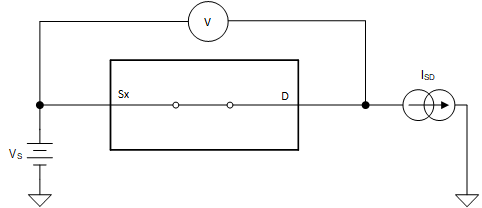SCDS445D May 2022 – September 2024
PRODUCTION DATA
- 1
- 1 Features
- 2 Applications
- 3 Description
- 4 Device Comparison Table
- 5 Pin Configuration and Functions
- 6 Specifications
- 7 Parameter Measurement Information
- 8 Detailed Description
- 9 Application and Implementation
- 10Device and Documentation Support
- 11Revision History
- 12Mechanical, Packaging, and Orderable Information
7.1 On-Resistance
The on-resistance of a device is the ohmic resistance between the source (Sx) and drain (D) pins of the device. The on-resistance varies with input voltage and supply voltage. The symbol RON is used to denote on-resistance. The measurement setup used to measure RON is shown in the following figure. Figure 7-1 shows how the RON is computed with RON = V / ISD, and the voltage (V) and current (ISD) are measured using this setup.
 Figure 7-1 On-Resistance Measurement Setup
Figure 7-1 On-Resistance Measurement Setup